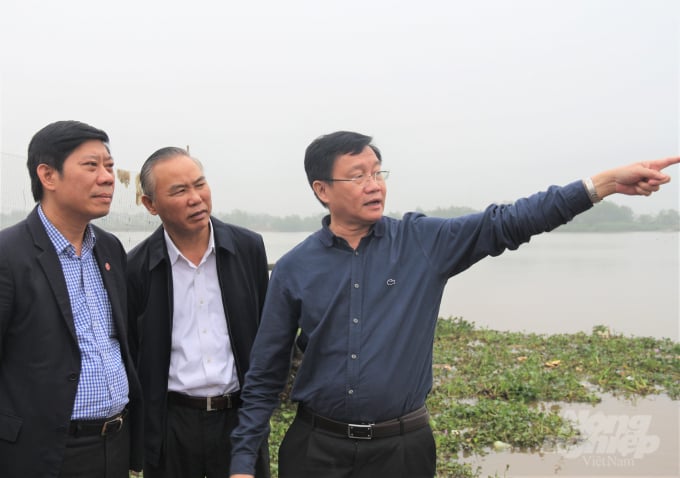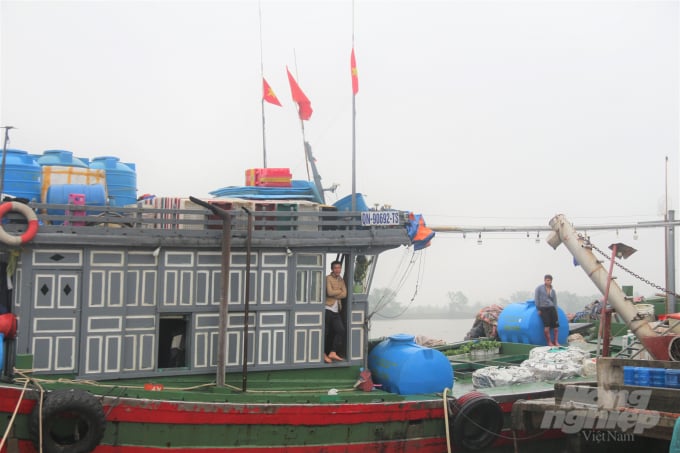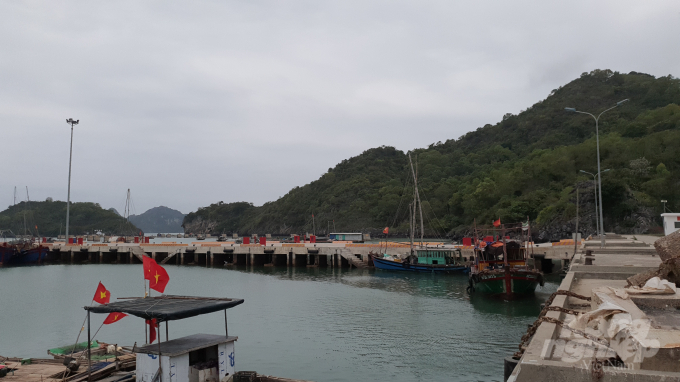October 28, 2025 | 18:00 GMT +7
October 28, 2025 | 18:00 GMT +7
Hotline: 0913.378.918
October 28, 2025 | 18:00 GMT +7
Hotline: 0913.378.918
On March 11th, 2021, the Prime Minister signed Decision No. 339/QD-TTg approving the Strategy for the development of Vietnam's fisheries to 2030, with a vision to 2045.
Accordingly, the fishery industry needs to be built into an economic sector with large scale and large goods proportion, a reputable brand, deep involvement in the global supply chain, high and sustainable competitiveness; deep international integration, responsible development towards the circular economy, improving productivity, quality, added value and efficiency.

Deputy Minister of Agriculture and Rural Development Phung Duc Tien (center) inspects Thuy Tan fishing port (Thai Binh) in April 2021. Photo: Pham Hieu.
Some key targets that the fisheries sector should strive for by 2030: The growth rate of aquaculture production value reaches 3.0 - 4.0%/year. Total domestic production of fisheries products reaches 9.8 million tons; in which aquaculture production is 7.0 million tons, the fishing output is 2.8 million tons.
According to Deputy Minister of Agriculture and Rural Development Phung Duc Tien, in order for the fisheries sector to achieve the goals above, it is necessary to implement many solutions synchronously, and upgrading fisheries infrastructure is a solution that is considered of utmost importance.

Deputy Minister Phung Duc Tien said that upgrading fisheries infrastructure is a solution that is considered the most important in developing the fisheries industry. Photo: Pham Hieu.
The MARD is urgently doing the review with localities to initiate the Sustainable Fisheries Development Project in order to promptly acquire resources to upgrade infrastructure for the fisheries sector in service of the Vietnam Fisheries Development Strategy to 2030, with a vision to 2045.
This project is funded by a loan from the World Bank (WB). Accordingly, the project aims to improve management capability and added value of fisheries products, international integration, and climate change adaptation. The project is expected to be implemented in the 2021-2026 period, which will have great significance for the seafood industry. This is also one of the projects to help Vietnam remove the IUU "yellow card".

The Sustainable Fisheries Development Project will promptly invest in infrastructure for the fisheries industry in the coming period. Photo: TL.
In order to timely remove obstacles in project implementation, on July 9th, the MARD has held an online meeting with several coastal provinces that launched the project such as Nghe An, Binh Thuan, Kien Giang, and Soc. Moon, Ca Mau...
At the meeting, Deputy Minister of Agriculture and Rural Development Phung Duc Tien asked localities implementing the project to urgently complete procedures, establish focal points for execution, and coordinate with the World Bank and the Agriculture Project Management Board as well as the MARD‘s Department of International Cooperation.
Moreover, localities need to complete the legal basis processes as well as speed up site clearance; prepare and arrange reciprocal capital sources; review and concretize actions to ensure the highest investment efficiency.
According to the report of the Directorate of Fisheries (MARD), in the first 6 months of 2021, the total fishery production is estimated at 4.1 million tons, up 3% over the same period in 2020. In which, the fishery exploitation volume reached nearly 2 million tons (up 1%), fisheries production volume reached 2.1 million tons (up 4%). The seafood export turnover in the first 6 months of the year was estimated at USD 4 billion, up 13.6% over the same period in 2020.

(VAN) The Integrated Plant Health Management (IPHM) helps farmers in Quang Ngai increase rice production efficiently and sustainably.

(VAN) Developing low-emission cultivation technology packages, MRV system, strengthening multi-stakeholder cooperation are to realize the goal of low-emission crop production.
/2025/10/23/5928-2-194850_964.jpg)
(VAN) The 'Regenerative cocoa production to support livelihood development in Vietnam' (ReCoPro) project marks an important step toward sustainable cocoa production.

(VAN) Reducing antibiotic dependence in livestock production helps protect public health, enhance food safety, and promote sustainable agricultural development.

(VAN) Experts describe Viet Nam as a 'policy laboratory' within ASEAN, where new agroecological, green finance, and risk-management initiatives are being piloted before wider regional adoption.

(VAN) Limiting rice straw burning and reusing agricultural by-products as materials or fertilizers not only improves soil health but also helps clean the air.

(VAN) ASSET delivers long-term vision and strategy, innovative models, learning networks, policy impact, and measurable environmental benefits.